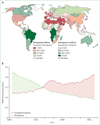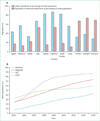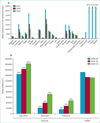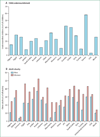Health and ecological sustainability in the Arab world: a matter of survival
- PMID: 24452051
- PMCID: PMC4238938
- DOI: 10.1016/S0140-6736(13)62338-7
Health and ecological sustainability in the Arab world: a matter of survival
Erratum in
- Lancet. 2014 Feb 1;383(9915):412
Abstract
Discussions leading to the Rio+20 UN conference have emphasised the importance of sustainable development and the protection of the environment for future generations. The Arab world faces large-scale threats to its sustainable development and, most of all, to the viability and existence of the ecological systems for its human settlements. The dynamics of population change, ecological degradation, and resource scarcity, and development policies and practices, all occurring in complex and highly unstable geopolitical and economic environments, are fostering the poor prospects. In this report, we discuss the most pertinent population-environment-development dynamics in the Arab world, and the two-way interactions between these dynamics and health, on the basis of current data. We draw attention to trends that are relevant to health professionals and researchers, but emphasise that the dynamics generating these trends have implications that go well beyond health. We argue that the current discourse on health, population, and development in the Arab world has largely failed to convey a sense of urgency, when the survival of whole communities is at stake. The dismal ecological and development records of Arab countries over the past two decades call for new directions. We suggest that regional ecological integration around exchange of water, energy, food, and labour, though politically difficult to achieve, offers the best hope to improve the adaptive capacity of individual Arab nations. The transformative political changes taking place in the Arab world offer promise, indeed an imperative, for such renewal. We call on policy makers, researchers, practitioners, and international agencies to emphasise the urgency and take action.
Copyright © 2014 Elsevier Ltd. All rights reserved.
Conflict of interest statement
We declare that we have no conflicts of interest.
Figures








Similar articles
-
The Minderoo-Monaco Commission on Plastics and Human Health.Ann Glob Health. 2023 Mar 21;89(1):23. doi: 10.5334/aogh.4056. eCollection 2023. Ann Glob Health. 2023. PMID: 36969097 Free PMC article. Review.
-
Chinese villages and their sustainable future: the European Union-China-Research Project "SUCCESS".J Environ Manage. 2008 Apr;87(2):204-15. doi: 10.1016/j.jenvman.2007.06.012. Epub 2007 Sep 20. J Environ Manage. 2008. PMID: 17888563
-
The quadruple squeeze: defining the safe operating space for freshwater use to achieve a triply green revolution in the anthropocene.Ambio. 2010 May;39(3):257-65. doi: 10.1007/s13280-010-0033-4. Ambio. 2010. PMID: 20701182 Free PMC article.
-
Egypt at the crossroads.People Planet. 1992;1(4):10, 12, 16-7, 19. People Planet. 1992. PMID: 12344703
-
Long-term trends and a sustainability transition.Proc Natl Acad Sci U S A. 2003 Jul 8;100(14):8062-7. doi: 10.1073/pnas.1231331100. Epub 2003 Jun 26. Proc Natl Acad Sci U S A. 2003. PMID: 12829798 Free PMC article. Review.
Cited by
-
Saudi Arabia's Maternal and Child Health Scenario Interpreted.Matern Child Health J. 2023 May;27(5):759-765. doi: 10.1007/s10995-023-03634-3. Epub 2023 Mar 27. Matern Child Health J. 2023. PMID: 36971974
-
One Health and planetary health research landscapes in the Arab world.Sci One Health. 2025 Feb 14;4:100105. doi: 10.1016/j.soh.2025.100105. eCollection 2025. Sci One Health. 2025. PMID: 40092474 Free PMC article. Review.
-
A Systematic Review on the Outcomes of Climate Change in the Middle-Eastern Countries: The Catastrophes of Yemen and Syria.Environ Health Insights. 2024 Dec 13;18:11786302241302270. doi: 10.1177/11786302241302270. eCollection 2024. Environ Health Insights. 2024. PMID: 39679384 Free PMC article. Review.
-
Understanding the bearable link between ecology and health outcomes: the criticality of human capital development and energy use.Heliyon. 2022 Dec 22;8(12):e12611. doi: 10.1016/j.heliyon.2022.e12611. eCollection 2022 Dec. Heliyon. 2022. PMID: 36619406 Free PMC article.
-
Analysis of the Implementation Effect of College Curriculum Ideological and Political under the Background of Ecological Sustainable Development.J Environ Public Health. 2022 Aug 9;2022:3937168. doi: 10.1155/2022/3937168. eCollection 2022. J Environ Public Health. 2022. Retraction in: J Environ Public Health. 2023 Aug 2;2023:9836216. doi: 10.1155/2023/9836216. PMID: 35983508 Free PMC article. Retracted.
References
-
- UN Environment Programme. Environmental outlook for the Arab region (EOAR) Nairobi, Kenya: United Nations Environment Programme; 2010.
-
- Saab N, editor. Arab environment 5. Survival options: ecological footprint of Arab countries. Beirut, Lebanon: Arab Forum for Environment and Development; 2012.
-
- Mokdad, Jaber S, Abdel Aziz MI, et al. The state of health in the Arab world, 1990–2010: an analysis of the burden of diseases, injuries, and risk factors. Lancet. 2014 published online Jan 20 http://dx.doi.org/10.1016/S0140-6736(13)62189-3. - DOI - PubMed
-
- Rio+20 world leaders. [accessed Oct 5, 2012];The future we want: outcome document adopted at the Rio+20 conference. http://www.uncsd2012.org/content/documents/727The%20Future%20We%20Want%2....
MeSH terms
Grants and funding
LinkOut - more resources
Full Text Sources
Other Literature Sources
Miscellaneous

